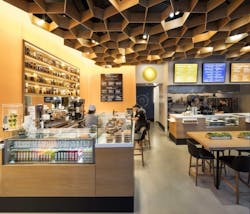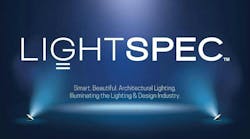Register for the on-demand webcast, "Transforming built spaces with healthy lighting"
1. Developing appropriate human-centric lighting — or lighting for health and wellbeing — is more than just delivering lumens in a finite spectrum.
Right off the top, Figueiro was very clear on this point: Brightness alone isn’t an indicator of quality lighting in these applications. And neither is a static correlated color temperature (CCT). The timing and amount of light matters to the human biological system. “Every photon counts,” she maintained. The LRC’s studies were designed to measure cumulative light exposure that would affect circadian rhythms and consequently other biomarkers for health and wellbeing.
2. Maybe you won’t need that afternoon espresso with a shift in lighting strategy.
No more afternoon espresso: You can promote alertness with a shot of the right light at the right times, when alertness tends to dip, when the lighting is designed to provide an appropriate circadian stimulus (CS). Learning about CS is really going to help smooth out any wrinkles in our understanding of lighting’s impact on circadian rhythms. Our contributing editor Mark Halper had discussed this recently with Figueiro when reporting on human-centric lighting in the workplace for our October issue. You can also get the tools you need to understand and calculate CS on the Light and Health section of the LRC website.
3. Blue light doesn’t need to get all the love — right on, red!
The LRC team’s studies also found that blue isn’t the only stimulating spectrum of light, just the one that mainly affects melatonin levels, which is why getting blue-rich white light at the wrong times of day can mess with your ability to sleep well. Figueiro pointed out that light in the red spectrum did not impact melatonin levels, but it was shown to improve subjective and objective measures of alertness when applied during the post-lunch dip in energy. You know the one — it makes you reach for that aforementioned espresso or anything else that might punch up your stamina temporarily.
4. Bring on the layers.
Both Figueiro and Hamilton emphasized the fact that one single lighting solution (or form factor, if you will) would not fit all spaces and their intended uses. Tunable lighting can be applied in downlights, accent lighting, close-up task lighting, just to name a few examples. Hamilton explained that in all the case studies he mentioned during the webcast, the designers involved in each space considered how it would be used and by whom. Overhead lighting was the mainstay but it can take many different forms, and individual areas or workspaces might need a shot of dynamic lighting — say, near a computer desk you might apply some of that red-tuned light or you might want to dim the fixtures to see the screen better. And daylight can and should be taken into account as well. Lighting should be layered in the space and easily controlled to best serve the changing needs of the occupants.
5. Prioritize the people and it will pay dividends.
Hamilton echoed a sentiment we read recently on the necessity of user-friendly and dynamic controls to achieve human-centric lighting designs. In our October issue, Legrand’s Charles Knuffke wrote that “[t]he effort to keep workers healthy, engaged, and attentive is a cause rooted in very real financial outcomes. And just as ergonomic chairs and keyboards, on-site health centers, and standing desks have helped businesses to have happier, healthier employees, HCL offers an additional opportunity to improve worker outcomes.” Hamilton noted that in all of his project examples, the decision makers involved understood the value proposition of a healthier kind of lighting system, including how to make it work with the building aesthetics. It was as important to the experience, comfort, and usability of the workplace as a wellness center, energy efficiency efforts, or sustainable materials in the building. And Ketra’s Natural Light system is designed to provide that ease of control and really fine-tune the light delivery, with the ability to determine the appropriate illuminance levels and CCT, generating a beautiful quality of light across whites and colors. We’re not promoting a commercial here, just evidence that research applied in commercialization can foster a healthier and more productive environment.
View the full webcast on demand from our landing page.






